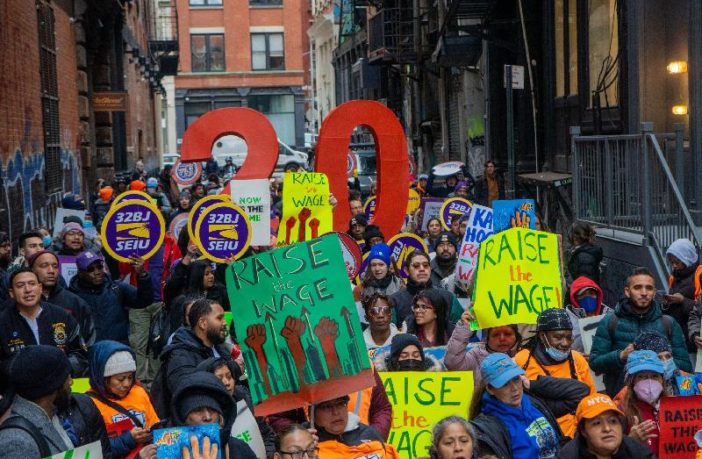Raise Wages Rally (Derek French-Shutterstock)
*(CNN) — The current period of high inflation that has significantly impacted the US economy will also influence a New Year’s tradition: The annual state minimum wage increases.
By January 1, hourly minimum wages in 23 states will rise as part of previously scheduled efforts to reach $15 an hour or to account for cost-of-living changes. The increases account for more than $5 billion in pay boosts for an estimated 8.4 million workers, the Economic Policy Institute estimates.
Additionally, nearly 30 cities and counties across the US will increase their minimum wage, according to the EPI, a left-leaning think tank.
The larger-than-typical increases for a dozen states come after inflation hit a 40-year high this summer, leaving families struggling to keep up with the rising costs.
“The fact that there’s high inflation really just underscores how necessary these minimum wage increases are for workers,” said Sebastian Martinez Hickey, a research assistant at the EPI. “Even before the pandemic, there was no county in the United States where you could affordably live as a single adult at $15 an hour.”
MORE NEWS ON EURWEB: California Reparations Task Force Aims to Pay $223K Per Person Via the ‘Bureau of African American Affairs’
The pandemic and the subsequent period of economic recovery has further revealed the growing chasm in America’s wealth gap. During the past two years, working conditions and low pay contributed to a swelling of labor movement activity and actions by many large corporations to raise their wage floor.
The pandemic also led to a structural upheaval in the nation’s labor market, creating an imbalance of worker supply and demand that still persists. Employers have found themselves short of workers for most of the year, which has pushed up average annual hourly wages in the battle to recruit and retain staff. While some workers in competitive industries such as retail and dining have found their new salary outpaces inflation, most pay has been outpaced by rising prices.
“The story is different because wages have been increasing at the low-end, much faster than inflation and much faster than in middle- or high-wage jobs,” said Michael Reich, economics professor at the University of California at Berkeley. “And that means that many workers, even in the $7.25 states, are already getting paid above the minimum wage.”
In other words, he said, the minimum wage “has become less and less binding.”
“Even though minimum wages might go up by 7%, in many states and cities, labor costs aren’t going to go up anywhere as much as they have in the past, because they already have gone up,” he said. “That also means that prices aren’t going to go up at [places like]restaurants.”
The federal minimum wage of $7.25 per hour hasn’t budged since 2009, and 20 states have a minimum wage either equal to or below the federal level, making $7.25 their default baseline. The value of the federal minimum wage peaked in 1968 when it was $1.60, which would be worth about $13.46 in 2022, based on the Bureau of Labor Statistics’ inflation calculator.
States with scheduled minimum wage increases on December 31, 2022, or January 1, 2023
Delaware: $10.50 to $11.75
Illinois: $12 to $13
Maryland: $12.50 to $13.25
Massachusetts: $14.25 to $15
Michigan: $9.87 to $10.10
Missouri: $11.15 to $12
Nebraska: $9 to $10.50
New Jersey: $13 to $14.13* (scheduled increase also includes inflation adjustment)
New Mexico: $11.50 to $12
New York: $13.20 to $14.20 (Upstate New York); $15 (in and around NYC)
Rhode Island: $12.25 to $13
Virginia: $11 to $12
Cost of living increases of state minimum hourly wages:
Alaska: $10.34 to $10.85
Arizona: $12.80 to $13.85
California: $14.50 (firms with 25 or fewer employees) /$15 (firms with 26+ employees) to $15.50
Colorado: $12.56 to $13.65
Maine: $12.75 to $13.80
Minnesota: $8.42 to $8.63 (small employer); $10.33 to $10.59 (large employer)
Montana: $9.20 to $9.95
Ohio: $9.30 to $10.10
South Dakota: $9.95 to $10.80
Vermont: $12.55 to $13.18
Washington: $14.49 to $15.74
Later in 2023:
Connecticut (effective July 1): $14 to $15
Florida (September 2023): $11 to $12
Nevada (effective July 1): $9.50 to $10.25 (firms that offer benefits); $10.50 to $11.25 (no benefits offered)
Oregon: $13.50 (effective July 1, indexed annual increase to be based on the CPI)
Sources: State websites, National Conference of State Legislatures, Economic Policy Institute
The-CNN-Wire
™ & © 2023 Cable News Network, Inc., a Warner Bros. Discovery Company. All rights reserved.
We Publish News 24/7. Don’t Miss A Story. Click HERE to SUBSCRIBE to Our Newsletter Now!



